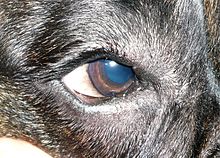- Distichia
-
Distichia Classification and external resources ICD-10 Q10.3 ICD-9 743.63 OMIM 126300 DiseasesDB 33329 eMedicine oph/603 A distichia is an eyelash that arises from an abnormal spot on the eyelid. The mutation affects dogs and humans. Distichiae usually exit from the duct of the meibomian gland at the eyelid margin. They are usually multiple and sometimes more than one arises from a duct. They can affect either the upper or lower eyelid and are usually bilateral. The lower eyelids of dogs usually have no eyelashes.[1] Distichiae usually cause no symptoms because the lashes are soft, but they can irritate the eye and cause tearing, squinting, inflammation, and corneal ulcers and scarring.[2] Treatment options include manual removal, electrolysis, electrocautery, cryotherapy, and surgery.
Contents
Commonly affected breeds
In veterinary medicine, some canine breeds are affected by distichiasis more frequently than others:
- Cocker Spaniel
- Dachshund (especially the miniature longhaired Dachshund)
- Bulldog
- Pekingese
- Yorkshire Terrier
- Flat-Coated Retriever
- Shetland Sheepdog
- Poodle[3]
- Elo (dog)[4]
Ectopic cilia
An ectopic cilia is a special type of distichia. It is usually found in younger dogs. Commonly affected breeds include Poodles, Golden Retrievers, and Shih Tzus.[5] The eyelash exits through the conjunctiva of the eyelid facing toward the eye, usually at the middle of the upper eyelid. It can cause intense pain and corneal ulcers. Treatment is surgery or cryotherapy.
In human beings
Elizabeth Taylor was born with the abnormality, although did not suffer any ill effects. Some have said that it enhanced the beauty of her eyes.[6] Although not a secret -- several biographies of Taylor make reference to this -- it did not become widely known by the public until after Taylor's death in 2011.
References
- ^ Brooks, Dennis E. (2005). "Ophthalmic Examination Made Ridiculously Simple". Proceedings of the 30th World Congress of the World Small Animal Veterinary Association. http://www.vin.com/proceedings/Proceedings.plx?CID=WSAVA2005&PID=10923&O=Generic. Retrieved 2007-02-20.
- ^ "Eyelids: Conformational Abnormalities". The Merck Veterinary Manual. 2006. http://www.merckvetmanual.com/mvm/index.jsp?cfile=htm/bc/30105.htm. Retrieved 2007-02-20.
- ^ Gelatt, Kirk N. (ed.) (1999). Veterinary Ophthalmology (3rd ed.). Lippincott, Williams & Wilkins. ISBN 0-683-30076-8.
- ^ Kaufhold J, Hamann H, Steinbach G, Gordon S, Brahm R, Grussendorf H, Rosenhagen C, Distl O (2006). "[Analysis of the prevalence of distichiasis in the dog breed Elo]". Berl Munch Tierarztl Wochenschr 119 (5-6): 233–7. PMID 16729470.
- ^ Ketring, Kerry I. (2006). "The Top Ten Ophthalmic Mistakes" (PDF). Proceedings of the North American Veterinary Conference. http://www.ivis.org/proceedings/navc/2006/SAE/308.pdf?LA=1. Retrieved 2007-02-20.
- ^ http://www.dailymail.co.uk/femail/article-1371197/Elizabeth-Taylor-The-genetic-mutation-gave-star-lashings-sex-appeal.html?ITO=1490
See also
Congenital malformations and deformations of eyes (Q10–Q15, 743) Adnexa Globe Entire eyeAnterior segmentOtherM: EYE
anat(g/a/p)/phys/devp/prot
noco/cong/tumr, epon
proc, drug(S1A/1E/1F/1L)
Categories:- Dog diseases
- Congenital disorders of eyes
Wikimedia Foundation. 2010.


